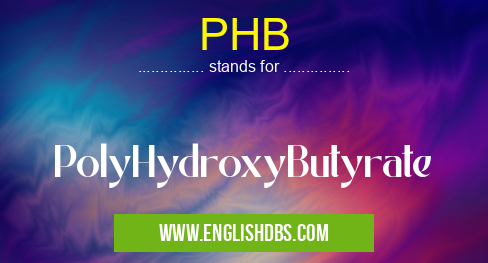What does PHB mean in CHEMISTRY
Poly-Hydroxy-Butyrate (PHB) is an abundant biopolymer widely used in a variety of industrial and consumer applications. PHB is extracted from bacterial cultures – making it a truly renewable material source that reduces the environmental impact of traditional petroleum-based plastics. It is naturally non-toxic and entirely biodegradable, as it has similar structural characteristics to lipids found in plant cell walls. With its sustainable production capability and unique properties, PHB has become an attractive option for various industries. From personal care to medical uses, PHB offers a reliable solution for those that require safe materials that are environmentally friendly.

PHB meaning in Chemistry in Academic & Science
PHB mostly used in an acronym Chemistry in Category Academic & Science that means PolyHydroxyButyrate
Shorthand: PHB,
Full Form: PolyHydroxyButyrate
For more information of "PolyHydroxyButyrate", see the section below.
Definition
Poly-Hydroxy-Butyrate (PHB) is an abundant biopolymer made up of hydroxybutyrate monomers — also known as 3-hydroxybutyric acid or 3HB — linked together by ester bonds and stored in granules within bacterial cells. PHB is naturally non-toxic, insoluble in most common solvents, heat resistant when processed within a certain temperature range and entirely biodegradable at the end of its life cycle.
Uses
PHB has multiple industrial uses due to its inherent properties such as excellent optical clarity, excellent barrier properties, strength and highly flexible processing capabilities. It can be used for packaging film or containers, medical disposables such as sutures and syringes; agricultural mulch films; composites for automotive interiors; personal care products such as bottles and caps; toys; insulation foam; household items like kitchen knives and utensils; disposable cutlery; electronics casings; specialty adhesives and paints among others.
Essential Questions and Answers on PolyHydroxyButyrate in "SCIENCE»CHEMISTRY"
What is Polyhydroxybutyrate (PHB)?
Polyhydroxybutyrate (PHB) is a biopolymer comprised of repeating units of 3-hydroxybutyric acid. It can exist in either a rigid or gel form, and it's synthesized by certain bacteria as an energy storage material. PHB is also biocompatible, biodegradable, and non-toxic, making it a popular choice for many medical applications.
What are the benefits of using Polyhydroxybutyrate (PHB)?
Some key benefits of PHB include its biocompatibility, biodegradability, non-toxicity, resistance to microbial attack, as well as a lack of antigenic response. This makes it ideal for medical applications such as implants, drug delivery systems and scaffolds for cellular growth. Additionally, its low water absorption means that it remains relatively stable when exposed to moisture.
What industries use Polyhydroxybutyrate (PHB)?
PHB has multiple industrial applications including its primary use in biomedical sciences for making medical devices like prostheses and tissue engineering scaffolds. It is also used cosmetically in hair gels, nail polishes, lipstick bases, etc., and environmentally for packaging materials like plastic films that can be used instead of traditional petroleum derived plastics.
How strong is Polyhydyxobutyrate (PHB)?
The strength and flexibility properties of PHB vary depending on its composition and molecular weight; however generally speaking it has an excellent tensile strength which makes it great for many applications such as packaging materials or medical devices where strength needs to be balanced with flexibility and durability. Additionally, its low water absorption means that it maintains much of its original mechanical properties when exposed to moisture.
Does Polyhydoxybutyarate (PHB) degrade in the environment?
Yes – one of the main advantages to using PHB over traditional petroleum based plastics is that it breaks down naturally via microbial processes into biomass and water over time rather than leaving behind toxic residues.
Is Polyhydroxybutyarate (PHB) safe?
Yes – PHB is widely considered to be non-toxic because it lacks any additives or other potentially harmful compounds. Furthermore, due to its very low water absorption level PHb does not leach out chemicals which makes it even safer when implanted in the body.
How do I store Polyhydroxybutyarate (PHB)?
As an organic compound PHb will begin to degrade if left unprotected at room temperature so proper storage should always involve reducing exposure to oxygen by sealing off any container tightly with a gas barrier layer like nitrogen or carbon dioxide then storing at 4°C or lower.
Final Words:
Poly Hydroxy Butyrate (PHB) is an abundant biopolymer with many beneficial attributes including being non-toxic, biodegradable, heat resistant and highly flexible during processing. Considering all these factors — plus its wide range of industrial applications from medical disposables to automotive interiors — PHB may prove to be an invaluable resource for industries seeking ways to reduce their environmental footprint while still providing high performance materials solutions for their respective needs.
PHB also stands for: |
|
| All stands for PHB |
